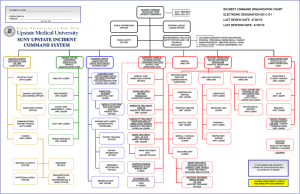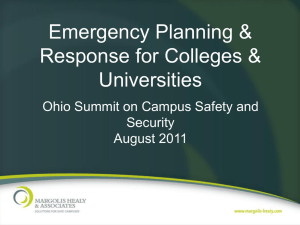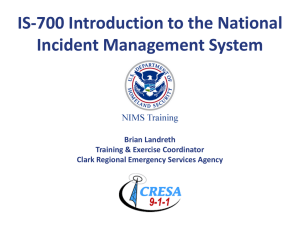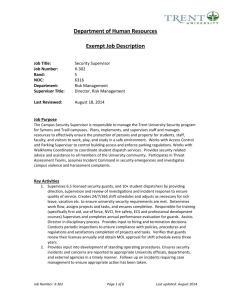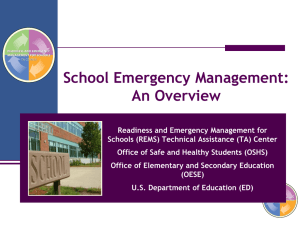What is an EOP? - Association of Community College Trustees
advertisement
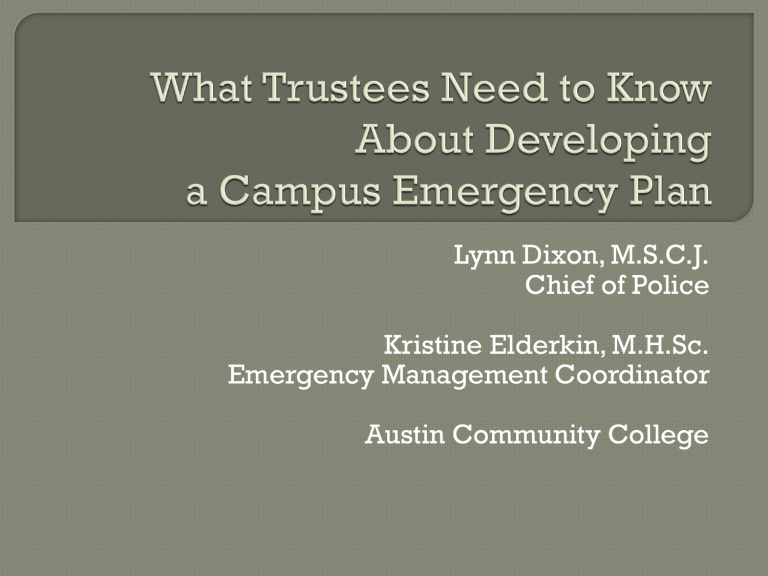
Lynn Dixon, M.S.C.J. Chief of Police Kristine Elderkin, M.H.Sc. Emergency Management Coordinator Austin Community College Kristine Elderkin Emergency Management Coordinator, Austin Community College District Health and Safety Coordinator; 15 years experience with Samsung, Kodak, GE, Municipality of Metro Toronto and Shell. Master of Health Science, University of Toronto Bachelors in Chemistry, McMaster University kelderki@austincc.edu Chester “Lynn” Dixon Chief of Police, Austin Community College District Adjunct Professor with Austin Community College – Criminal Justice Master of Science Criminal Justice from Texas State University Retired Lieutenant, Texas Department of Public Safety • Specialized in Management and Fire Arms Training Former DPS SWAT Team Leader Commander of DPS Dive Recovery Team Federal Bureau of Investigation National Academy Graduate 34 years of law enforcement experience Trustees play a crucial role in developing policy A policy that provides ongoing support for emergency management helps to ensure the success of planning efforts at your college Effective emergency management begins with senior leadership on campus An emergency management initiative requires: • Administration support • Financial support • Involvement of the college community The purpose of this presentation is to provide insight into emergency management so that you can develop the best policy for your college By the end of this session, participants will be able to answer these questions: What is an Emergency Operations Plan? Is it required? What do trustees need to think about when it comes to campus emergency preparedness? 8 Counties 8 Campuses and 3 under construction 11 Learning Centers 100+ CE locations 2 Business Centers 5,000 Faculty & Staff 43,000 Students An Emergency Operations Plan (EOP) is a document that outlines how your college will prevent/mitigate, prepare for, respond to and recover from emergencies associated with: • Natural hazards, • Technological hazards, and • Adversarial or human-caused hazards Prevention-Mitigation Preparedness Response Recovery An PreventMitigate Prepare Recover Respond IHE emergency operations plan should use the four phases of emergency management to effectively prepare and respond to emergencies. Prevention is the action taken to decrease the likelihood that an event or crisis will occur. Mitigation is the action taken to eliminate or reduce the loss of life and property damage related to an event. In order to properly prioritize prevention-mitigation projects, a risk assessment is essential All the hazards that threaten your college’s jurisdiction must be considered Access Preparedness is the action taken to design processes and protocols to prepare for potential emergencies. Many assessment tools are available. The “Texas Public Junior College Safety and Security Audit” must be completed every three years (Texas Education Code 37.108) Licensed peace officers empowered by the State of Texas Operate 24/7/365 Patrol campus Enforce laws Enforce policy First point of contact for campus emergencies Functions: • Dispatch of, communication with and tracking of Officers • District-wide fire and security alarm monitoring • Liaison between ACC and 911, Police, Fire and EMS • Staffed 24/7/365 Police & EM • Regulatory required training • ICS, NIMS • Active Shooter Response • Professional development E-Teams • Emergency Team duties • First Aid, CPR, AED • Fire Extinguisher Faculty & Staff • New Employee Orientation • Regulatory required training • First Aid, CPR, AED Students • New Student Orientation • In-class orientation For everyone: crime prevention, active shooter awareness, severe weather awareness, on-going emergency procedures training Exercises are used to test and improve plans and procedures. Examples: • Building evacuation drills • Shelter-in-place drills • Lock-down drills • Emergency communication protocols Exercises are an opportunity to collaborate with community partners AREA OF RESCUE ASSISTANCE Email, phone and text message Emergency message boards and speakers HELP desk phone line Desk phones Social media Channel 19 Local media Raise awareness, share information Conduct drills Third week of every semester Verify equipment operation Test emergency procedures Response involves taking action to contain and resolve an emergency effectively. Stay away from campus Shelter in place Reverse evacuation Lockdown Full/partial evacuation of building/campus Drop, cover and hold Recovery establishes procedures, resources and policies to assist an institution and its members to return to functioning after an emergency. A Continuity of Operations Plan is preplanned. It documents the college’s: • Essential Functions • Lines of Succession • Delegation of Authority • Continuity Facilities • Continuity of Communications • Vital Records Management • and more… Physical and structural recovery Business recovery Restoring the learning environment Psychological and emotional recovery A damage assessment determines the extent of the effects of the incident on campus and community physical assets and identifies newly created vulnerabilities. The college can restore administrative and business function using their Continuity of Operations Plan. This phase of restoration may involve: • conducting classes in offsite locations, • implementing online learning, and • implementing temporary procedures re: grading, attendance, graduation requirements, etc. Administrators must make swift decisions and communicate them effectively. It is critical to identify the mental health resources (both short - and long-term) in collaboration with partners to promote this part of the recovery. The best things people can do: donate cash to legitimate organizations and donate blood. The PreventMitigate Prepare Recover Respond cycle as a whole is an ongoing process, just as the EOP is a dynamic document that requires continual updating. IHEs have a commitment to ensure the safety of those on their campuses Pre-planning can prevent an emergency; minimize it’s effects; facilitate a rapid and effective response; and quicken recovery Federal & State authorities and mandates require public colleges to have an EOP Texas Education Code Chapter 37, Section 108 Robert T. Stafford Disaster Relief and Emergency Assistance Act (Stafford Act) The Higher Education Opportunity Act The Jeanne Clery Disclosure of Campus Security Policy and Campus Crime Statistics Act (Clery Act) Homeland Security Presidential Directive #5 (HSPD-5) HSPD-5 (issued in 2003 in response to 9-11) mandates the use of NIMS Homeland Security Presidential Directive #5 NIMS provides a framework for incident management and requires ICS National Incident Management System ICS defines incident response organizational concepts and structures Incident Command System DHS and ED recommend all IHEs implement NIMS and adopt ICS Compliance is tied to eligibility for some Federal funds and grants The Incident Command System: • Is based on proven incident management practices • Defines incident response organizational concepts and structures • Consists of procedures for managing personnel, facilities, equipment and communications • Is used through the lifecycle of an incident Resources and training are available through the Department of Education , FEMA, and many professional associations (IAEM, IACLEA) Goal of REMS: To support schools and IHEs in the development of comprehensive allhazards emergency management plans Action Guide for Emergency Management at Institutions of Higher Education Balancing Student Privacy and School Safety: A Guide to FERPA for Colleges and Universities A Guide to Vulnerability Assessments: Key Principles for Safe Schools Building a Disaster-Resistant University Multi-Hazard Emergency Planning for Higher Education (L363) Incident Command System Overview for Executives/Senior Officials (G402) Emergency Planning for Campus Executives Introduction to the Incident Command System for Higher Education (IS-100.HE) National Incident Management System (IS-700) (G367) One of 23 executive actions President Obama announced : “Develop model emergency response plans for schools, houses of worship and institutions of higher education” January 26, 2013 Prohibit weapons on campus Conduct awareness seminars Provide emergency procedures “See Something, Say Something” Patrol campuses and interact frequently with students Help assess behavioral concerns Develop a Workplace Violence program Use ACC Emergency Alert to provide initial warning and follow-up messages Students, faculty and staff implement emergency procedures for selfprotection ACC Police Officers are trained to respond immediately, even if alone 1. Is emergency management a priority for senior Campus Executives? 2. What plans are in place to protect students, faculty, staff and property? 3. Has a comprehensive continuity of operations plan been developed? 4. What are the highest priority hazards facing the college? 5. How is compliance with State and Federal laws managed? By the end of this session, participants will be able to answer these questions: What is an Emergency Operations Plan? Is it required? What do trustees need to think about when it comes to campus emergency preparedness?

